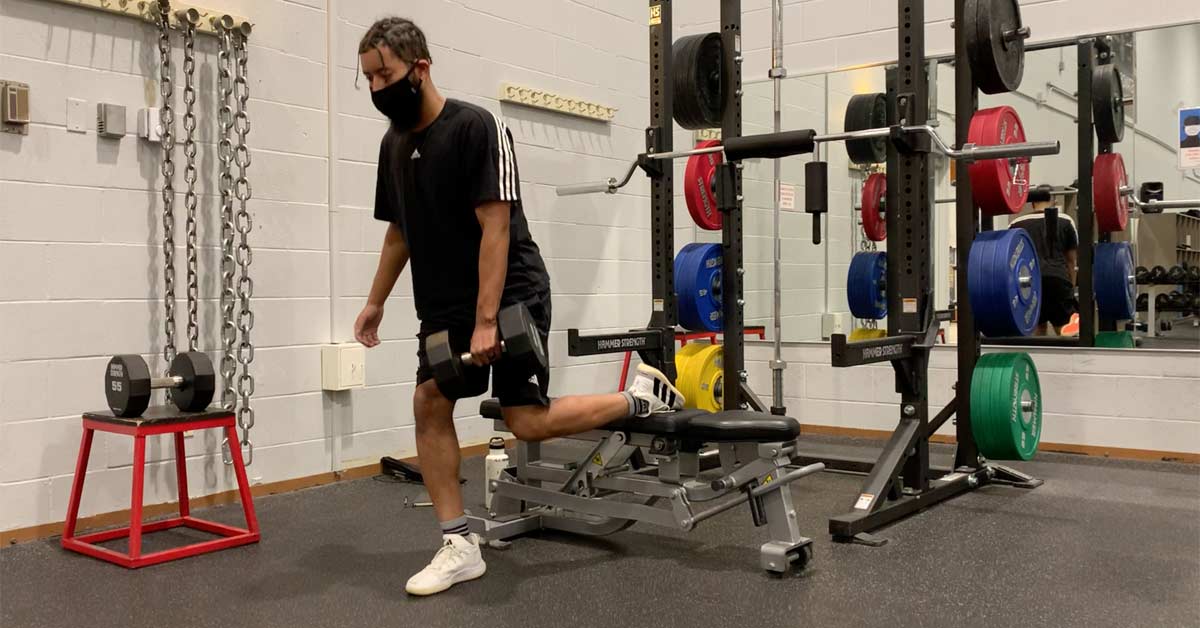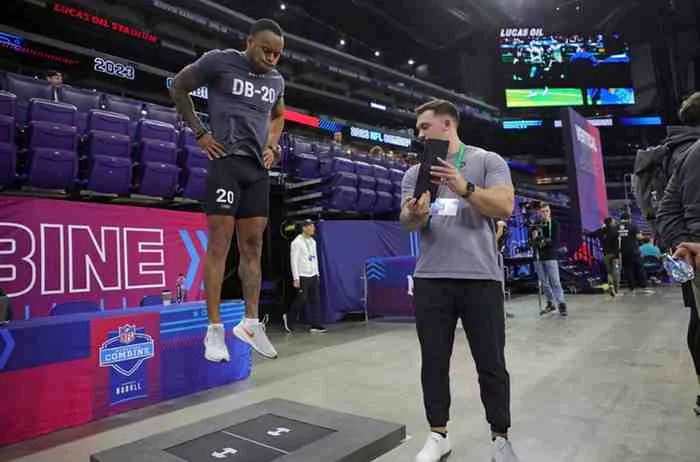The 2011-12 NBA basketball season was off to a tough start—having been shortened due to the lockout, players and fans alike were excited to get back to supporting the teams and players they knew and loved. The excitement was particularly high for a young guard who was hungry to make his mark on the league. But on March 10th, 2012, a severe ankle sprain threatened the player’s career—this was one of a string of major ankle injuries to be experienced by the star you may know as one of the Splash Bros: Steph Curry.
Ankle sprains are an all-too-common injury that plagues athletes at all levels of play, and they can be devastating. The effects of an ankle injury can outlast an athlete’s career in extreme instances, with the most severe cases requiring surgery. These injuries are often combatted with high top shoes, ankle taping, and restrictive ankle braces…but what if the very elements that athletes look to for safety are the things that are actually leading to more injuries?
Ankle sprains are an all-too-common injury that plagues athletes at all levels of play, and they can be devastating, says @Jucaelite. Share on XMobility and Stability
The ankle is a hinged, synovial joint that chiefly operates through dorsi and plantar flexion, in addition to inversion and eversion. The ankle is also capable of circumduction (a combination of the above movements), and it has been suggested that it is also capable of medial and lateral rotation.
Regardless of its ability to rotate, taken together this demonstrates that the ankle is a very mobile joint, and was designed to operate as such. The joints of the body operate in a remarkable, alternating fashion all the way up to the head and neck. For example, the foot is designed with more of a stability bias while the ankle is more mobile; the knee is more stable while the hip is more mobile; the low back is stable while the thoracic spine is mobile; and the scapula-thoracic joints have an element of stability while the cervical spine upon which the cranium sits has a more mobile bias.
These rules are not clean-cut, especially in the case of the scapula-thoracic and cervical spine, which are capable of quite a bit of mobility. However, the point can be illustrated that they have more of a stability bias as illustrated by the body’s response to scapular winging or issues of cervical instability, which are sometimes characterized by dizziness and vertigo, balance issues, and difficulty holding up the head.
So if the ankle is a mobile joint and designed to operate as such, what is the harm in introducing a little stability into it? The answer: MAJOR DYSFUNCTION.
Basketball is played at a high speed (at least if the athletes are good at the sport), and the body’s segments need to be able to respond at a high speed. When an athlete is moving quickly and needs to change direction, the joints act as shock absorbers to dampen the forces. When one of the stability–mobility pairs is not working up to par, then another joint will have to take up the slack and work double time. When that joint is at its breaking point, an injury can occur in the ankle (ankle sprain), knee (ACL tear), and many others. These components are only part of the whole picture (factors such as torsion, strength, and a smattering of other pieces fit into the injury puzzle), but restricting a mobile joint does not help in any respect.
When an athlete is moving quickly and needs to change direction, the joints act as shock absorbers to dampen the forces, says @Jucaelite. Share on XHigh Tops & Low Tops
In addition to braces and wraps, footwear can play a major part in limiting or promoting injuries, and even limiting or promoting athletic performance. In an article by Brizuela et al., performance in running, jumping, and injury resistance were looked at between two different prototype basketball shoes—a low top and a high top.
The results indicate significant differences between low and high top shoes. Studies of impact forces show higher impact forces in high top shoes that transmitted up to the forehead, potentially because of limited plantar flexion movement. What does this mean? There is potentially a higher risk for low back pain with high top shoes. In addition, the high top shoes demonstrated restricted ankle range of motion in eversion and plantar flexion, but also increased inversion (which is typically the most common type of ankle sprain). On performance tests, the high top shoes most limited vertical jump ability, but also decreased performance in running with direction changes.
On performance tests, the high top shoes most limited vertical jump ability, but also decreased performance in running with direction changes, says @Jucaelite. Share on XResults of this study demonstrate that high top shoes may be more appropriate for an athlete who isn’t required to move quickly as often (post players), but can limit performance for athletes who play at lower angles and at higher speed (guards). In addition, high top shoes may be appropriate for athletes suffering from a history of ankle sprains.
Is footwear the only factor that plays into an ankle sprain? Absolutely not. In total, athletes should look at the following solutions to attenuate against ankle injuries:
- Restoring stability of the foot.
- Restoring ankle mobility in all ranges.
- Limiting mobility disparities between limbs.
- Improving proprioception.
This list is generally ordered anatomically from the bottom up and is not exhaustive. When attacking dysfunction, I recommend focusing on areas that may be the cause of issues, whereas other areas may be the symptom. For example, dysfunction at the foot level may present as a dysfunction of the ankle. Once the foot has been addressed, the ankle may clear up. If, however, you address the ankle and then the foot, results may not prove as successful. Below are some solutions aimed at improving any limitations in the ankle and foot.
1. Restoring stability of the foot
To restore stability of the foot we must look at multiple structures. The arches of the foot, and the toes are all major players in stability that are commonly operating in dysfunction. The toes are often weak and immobile in the way that you are not able to consciously move them as you should. The toes are the fingers of the feet, and should be able to abduct (splay), adduct, flex, and extend. Any limitation in degrees of freedom will contribute to dysfunction. In addition to the exercises listed below, rolling the bottoms of the feet are highly encouraged. An example of how to roll the feet can be found here.
Exercises
- Flexion (curling the toes with the foot flat)/extension (raising the heel while keeping toes planted; also demonstrated in video above)
- Abduction/adduction (splaying the toes outward and inward)
2. Restoring ankle mobility in all ranges
Ankles are made to transmit forces up the chain to the muscles that can help to dampen forces that could transmit up the axial skeleton and cause damage. The major movements of the ankles are to plantar flex, dorsiflex, evert, invert, and circumduct. Additionally, the ankle pronates (dorsiflexion and eversion) and supinates (plantar flexion and inversion). By actively moving the ankles through these ranges, as well as manually manipulating the ankle, you can improve the function of the joint as a whole.
Ankles are made to transmit forces up the chain to the muscles that can help to dampen forces that could transmit up the axial skeleton and cause damage, says @Jucaelite. Share on XExercises
- Plantar flexion
- Dorsiflexion
Video 1. Ankle mobility, plantar flexion (pointing the toes down) and dorsiflexion (pulling the toes toward the shin).
Video 2. Front Foot Elevated Split Squat (drive the front knee forward past the toe).
Video 3. RFESS (keep back foot plantar-flexed, drive up).
Video 4. Eversion/inversion (move foot side to side), pronation (dorsiflex and evert), and supination (plantar flex and invert).
Video 5. Circumduction (circular motion).
Video 6. Manual manipulations (keep forefoot stable, manipulate heel side to side). More on this can be found in Anatomy Trains by Thomas Meyers.
3. Limiting disparities between limbs
Working together with the two previous points, if there is a major limitation in one joint as compared to the other, this should be a major focus.
4. Improving proprioception
Proprioception, put simply, is the awareness of the limbs in space as well as how fast they are moving and how much force they are producing. There are many ways to improve proprioception, including PNF stretches and patterns, but most functionally you can use balance exercises. If there is no injury present, unstable surfaces may provide some benefit—but manipulating other factors may prove more beneficial.
Video 7. Clock taps (lightly tap free foot).
Video 8. Limiting visual feedback (keep core engaged, slight bend in knee).
Video 9. Manipulating the vestibular system (keep core engaged, slight bend in knee).
Programming
Implementing these exercises periodically pre, during, or post training will greatly assist in reducing injury risk and cleaning up dysfunction. There is no one perfect method for avoiding injuries, but by making your approach multifactorial, you have a much better chance of succeeding in your efforts.
Implementing these exercises periodically pre, during, or post training will greatly assist in reducing injury risk and cleaning up dysfunction, says @Jucaelite. Share on XThe difficulty lies in how you program exercises in this category to keep the attention span of the population you are working with, while also not eating away the time you have for your session. One practical way I have used is to split your athletes into “buckets.” Each athlete would be put into a different bucket based on what they need most and perform the mobility exercises barefoot.
When athletes arrive, they grab their lift card (or a card made specifically for this group) and get to work on their own before the group warm up. In the early stages, it is crucial to take each group through the movements so you can set the tone. As time goes on you can let them take the wheel until the movements change, and then the cycle starts again. Additionally, I have found that some athletes need more than one exposure to a specific movement, or a different movement that attacks the same limitation. In this case, implementing one of these “correctives” during the rest period of a major lift can be a great way to make sure your athletes get adequate rest time. This can add density to their training and keep the movement quality high.
Since you’re here…
…we have a small favor to ask. More people are reading SimpliFaster than ever, and each week we bring you compelling content from coaches, sport scientists, and physiotherapists who are devoted to building better athletes. Please take a moment to share the articles on social media, engage the authors with questions and comments below, and link to articles when appropriate if you have a blog or participate on forums of related topics. — SF






